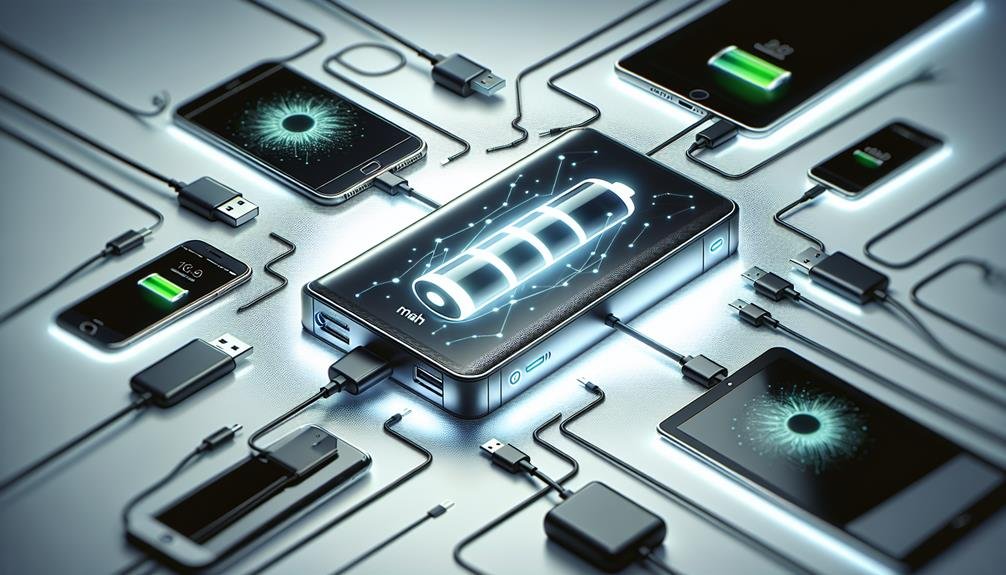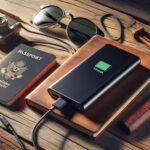When selecting a power bank, understanding 'mAh', which represents milliampere-hour, is vital. This unit gauges the electric charge capacity of the battery. Higher mAh indicates more stored energy and the capacity to charge your devices more times. It's important to take into account both mAh and charging efficiency, as efficiency losses can impact performance. The device's power usage also affects how long the power bank will last. By aligning the mAh rating with your device's requirements, you guarantee peak performance. If you're interested in optimizing power bank usage and other technical insights, there's more to discover.
Understanding Mah
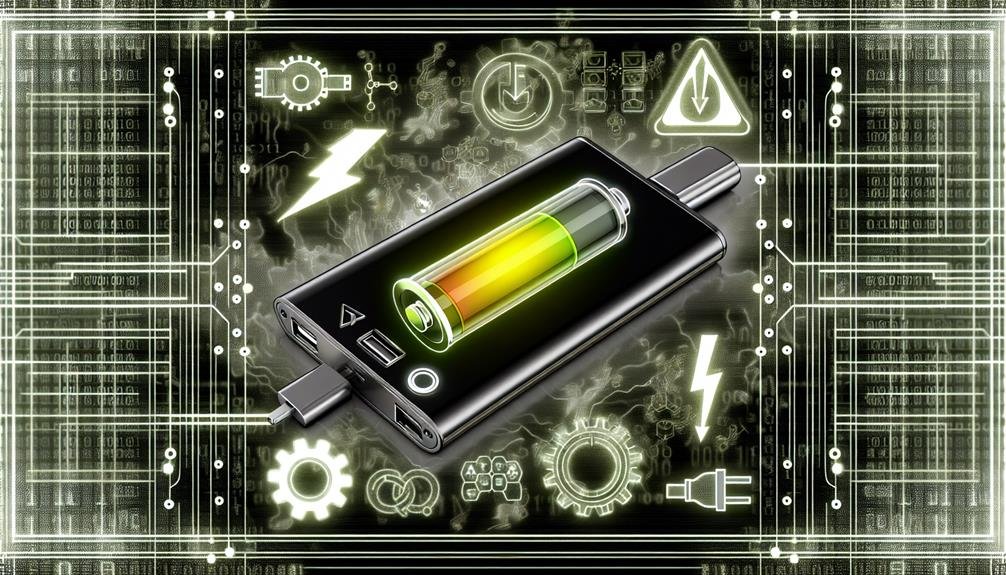
When you see 'mAh' on a power bank, it's essential to understand that it stands for milliampere-hour, a unit that quantifies the electric charge capacity of the battery. This number tells you how much charge the power bank can store and ultimately supply to your devices. A higher mAh means more stored energy, which translates to more charging cycles for your gadgets.
Charging efficiency plays a significant role in how effectively the stored energy is transferred to your device. Not all power banks are created equal; some lose a substantial amount of energy during the transfer process due to inefficiencies in their design or components. As a result, a power bank with high mAh but poor charging efficiency might not perform as well as one with a lower mAh but superior efficiency.
Power consumption of the device you're charging also affects the overall performance. Devices with higher power consumption will drain the power bank faster, reducing the number of full charges you can achieve.
Battery longevity is another critical aspect influenced by technology advancements. Modern power banks often incorporate features like smart charging and advanced circuitry to prolong battery life and ensure safety. These advancements not only improve performance but also enhance the longevity of the power bank itself.
How Mah Is Measured
To accurately gauge the capacity indicated by mAh, it's measured by determining the amount of current a battery can deliver over a specified period, typically one hour. For instance, a 2000mAh battery is expected to supply 2000 milliamps (or 2 amps) for one hour. This mah measurement is a standard metric used across the industry to provide a consistent basis for comparing battery capacities.
However, it's important to address mah misconceptions that can skew user expectations. The mAh rating doesn't account for variables like voltage fluctuations or efficiency losses, which can affect real-world performance. Industry standards ensure that mAh ratings are tested under controlled conditions, but these conditions may not always mirror everyday usage scenarios.
When you evaluate a power bank, understanding mAh helps you gauge how long it will last under specific loads. Remember, higher mAh ratings generally indicate longer battery life, but always consider the device's power requirements and usage patterns. This analytical approach guarantees that you make informed decisions, prioritizing both performance and safety. Keep these factors in mind to set realistic user expectations and avoid potential pitfalls related to mAh misconceptions.
Importance of Mah
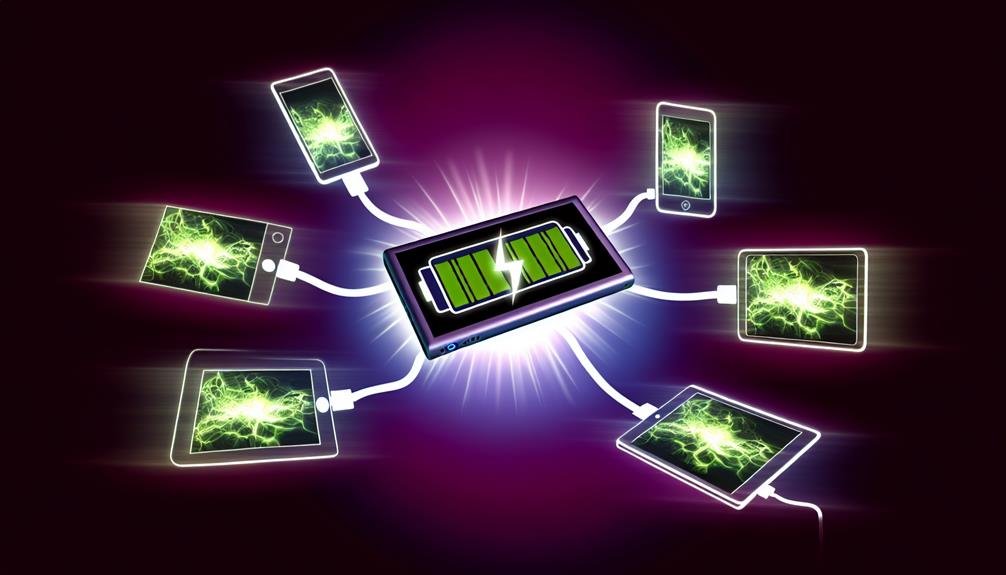
Understanding the importance of mAh is fundamental for making informed decisions about selecting the right power bank for your specific needs. The milliampere-hour (mAh) rating indicates how much charge a power bank can hold, directly influencing battery longevity and efficiency. Higher mAh values generally mean more extended usage times, which is vital if you have high power consumption and specific charging habits.
| Aspect | Explanation |
|---|---|
| Battery Longevity | A higher mAh rating guarantees your devices stay powered longer without frequent recharges. |
| Efficiency | Efficient power banks optimize the stored energy, minimizing energy loss during transfers. |
| Power Consumption | Understanding your device's power needs helps in choosing a power bank with a suitable mAh rating. |
When you know your device's power consumption, you can select a power bank that aligns with your charging habits, providing a balance between capacity and portability. For instance, if you're often on the go and use power-intensive applications, opting for a power bank with a higher mAh rating ensures that you won't run out of power when you need it most. Conversely, if your power needs are minimal, a lower mAh rating can be sufficient and more portable. This precise approach guarantees safety and reliability in your power bank selection.
Comparing Mah Ratings
When comparing mAh ratings on power banks, you'll need to take capacity and usage time into account, which directly affect how long your devices can stay powered. Additionally, make sure compatibility between the power bank's output and your device's requirements to avoid operational inefficiencies. Finally, understand that higher mAh ratings can impact charging speed, influencing overall device performance and power management.
Capacity and Usage Time
Comparing capacity ratings directly impacts your understanding of a power bank's ability and how long it can effectively charge your devices. The capacity (milliamp-hour) rating determines a power bank's charging ability, dictating how many times it can recharge your device before it needs recharging itself. Higher capacity ratings generally indicate a larger ability, meaning more charges for your devices. However, it's important to take into account the efficiency of the power bank. Efficiency losses can occur during the energy transfer process, typically ranging between 10-20%, which might reduce the practical usage time.
Evaluating a power bank's lifespan and durability is equally important. Consistent high capacity ratings, while beneficial for ability, can sometimes impact the overall longevity of the power bank. Over time, frequent charging cycles can degrade the battery, reducing its efficiency and effectiveness. In light of this, when evaluating capacity ratings, you should also take into account the quality of the internal battery and the manufacturer's reputation for durability.
Device Compatibility Considerations
Aligning your power bank's mAh rating with your device's power requirements is essential for the best charging performance and compatibility. You need to take into account several factors to make sure your device is charged safely and efficiently. Here's a structured approach:
- Device Compatibility: Compare the mAh rating of your power bank with your device's battery capacity. A power bank with a higher mAh rating will charge your device more times before needing a recharge itself. However, ensure its voltage output matches your device's requirements to prevent any damage.
- Charging Speed: Confirm the power bank's output current (measured in amps) aligns with your device's optimal charging rate. If your device supports fast charging, you'll need a power bank with a higher current output. Otherwise, you'll experience slower charging times, which might not be as efficient.
- Connector Type: Verify that the power bank's connectors are compatible with your device. Using the correct connector type ensures a stable connection, preventing issues such as overheating or inefficient charging.
Charging Speed Impact
Understanding how mAh ratings influence charging speed is vital for optimizing your device's recharging efficiency and performance. When comparing power banks, the mAh rating alone doesn't determine how fast your device will charge. Instead, it's the synergy between the power bank's mAh and its output current (measured in amperes) that dictates charging speed. High mAh ratings paired with inadequate output current can lead to suboptimal charging efficiency, thereby impacting the overall performance of your devices.
Consider a power bank with a 10,000 mAh rating and a 1A output. It will charge your device slower compared to a power bank with the same mAh but a 2A output. This is because higher output current translates to faster power delivery, reducing power consumption over time and potentially extending battery longevity. However, it's important to confirm that your device can handle the higher current to avoid overheating or damaging the battery.
Therefore, when evaluating power banks, prioritize a balanced approach. High mAh ratings coupled with appropriate output current ensure efficient charging, safeguard battery longevity, and minimize the adverse impact on devices. This careful consideration will maximize both the safety and performance of your electronic devices.
Mah and Battery Life
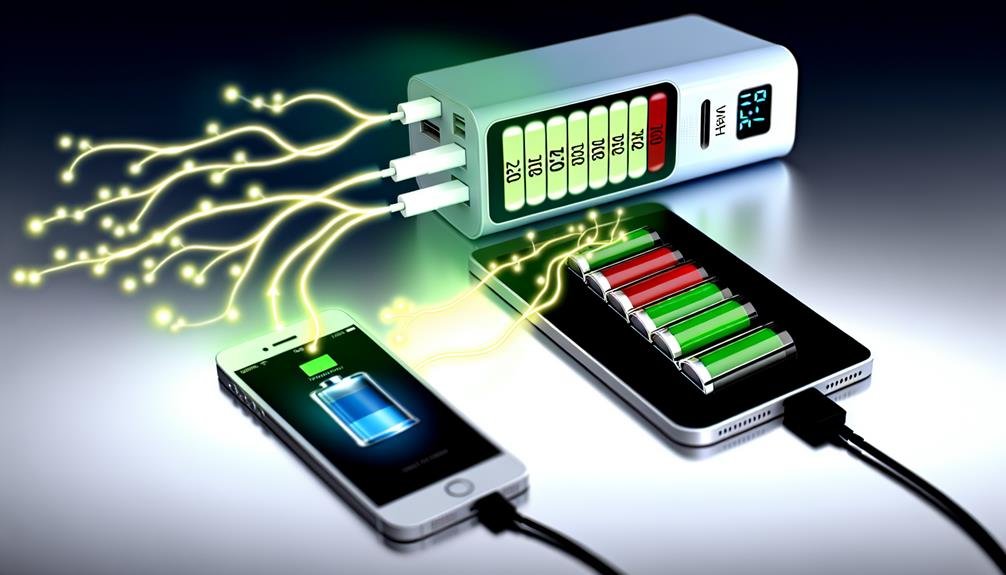
A power bank's mAh rating directly influences how long it can charge your devices before needing a recharge itself. Understanding this metric is essential for maximizing battery capacity and charging speed. The higher the mAh (milliampere-hour), the greater the energy storage, allowing the power bank to charge your devices multiple times or power larger devices. However, the efficiency of these charges also depends on the device compatibility.
Here are three key points to keep in mind:
- Battery Capacity: A higher mAh rating means more stored energy. For example, a 10,000 mAh power bank can theoretically charge a 2,000 mAh smartphone five times. However, always remember that actual performance may vary due to energy loss during the transfer.
- Charging Speed: While a high mAh rating indicates more energy, it doesn't directly affect charging speed. Charging speed is influenced by the output current (measured in amperes) and the device's compatibility with fast-charging technologies.
- Device Compatibility: Not all devices require the same amount of power. Verify that your power bank's mAh rating and output voltage are compatible with your devices to avoid potential damage or inefficient charging.
Choosing the Right Mah
Selecting the appropriate mAh rating for your power bank requires a detailed assessment of your device's energy needs and usage patterns. Begin by understanding the power bank capacity in relation to your device's battery. For example, if your smartphone has a 3,000 mAh battery, a 10,000 mAh power bank can theoretically charge it around three times, taking into account some loss due to charging efficiency.
However, charging efficiency is vital to consider, as it's never 100%. Typically, expect around 70-90% efficiency due to energy loss in the conversion process. To calculate this, multiply the power bank's capacity by its efficiency rate. For instance, with an 80% efficient 10,000 mAh power bank, the effective capacity is 8,000 mAh.
Assess your daily usage. If you frequently use your device for power-intensive applications, opt for a higher capacity power bank to make sure you're not left stranded without power. Conversely, if your usage is minimal, a lower capacity might suffice, offering portability and safety without excessive bulk.
Always prioritize safety features like overcharge protection and high-quality cells, regardless of capacity. This guarantees your device and power bank remain in optimal condition during repeated charging cycles.
Mah Vs. Watt-Hours
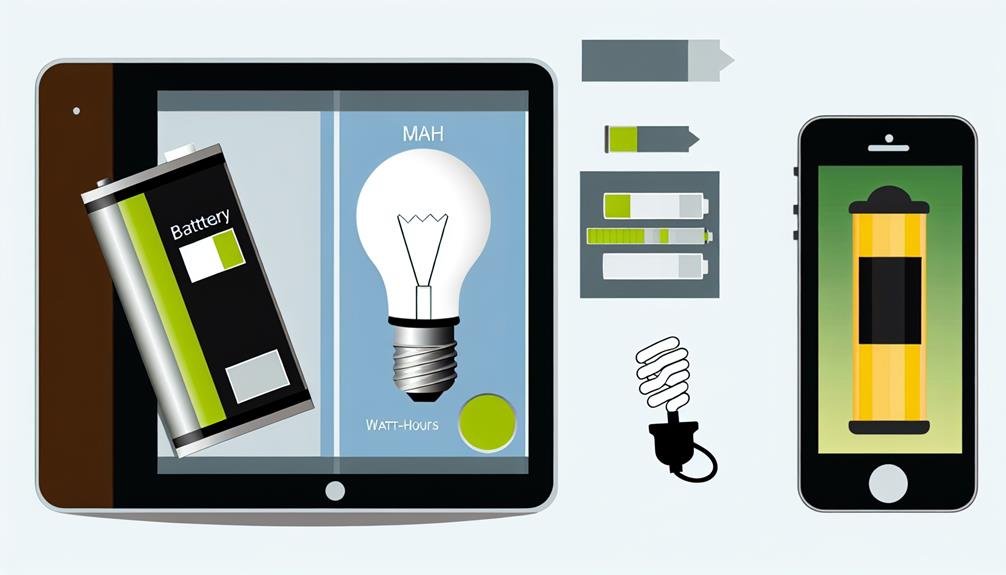
To effectively compare mAh and watt-hours, you'll need to understand their roles in indicating battery capacity. mAh measures the electric charge, while watt-hours calculate the total energy storage by factoring in voltage. By converting mAh to watt-hours, you can better assess a power bank's efficiency and suitability for your devices.
Understanding Battery Capacity
When evaluating battery capacity, understanding the difference between milliampere-hours (mAh) and watt-hours (Wh) is important for making informed decisions. Millampere-hours measure the charge capacity of a battery, indicating how much current a battery can deliver over time. In contrast, watt-hours measure the actual energy stored in the battery, which is a product of both voltage and current. Knowing these distinctions is essential for grasping battery technology and optimizing energy efficiency.
Let's break it down further:
- Milliampere-Hours (mAh): This unit quantifies the electric charge. A higher mAh value implies a longer battery life, but it doesn't account for voltage, which can vary across devices.
- Watt-Hours (Wh): This unit measures energy. It provides a more comprehensive view of battery capacity by incorporating voltage. For safety and accurate energy efficiency, converting mAh to Wh (using the formula Wh = mAh × V / 1000) allows you to compare batteries more effectively.
- Practical Implications: When choosing a power bank, consider both mAh and Wh. A higher Wh rating ensures longer usage and better energy efficiency, especially important for high-drain devices. Always check the voltage compatibility to avoid safety risks.
Calculating Energy Storage
Understanding the practical implications of battery capacity, you'll need to calculate energy storage by comparing milliampere-hours (mAh) with watt-hours (Wh) to make informed decisions. To do this, multiply the mAh rating by the nominal voltage of the power bank, then divide by 1,000. This conversion helps you gauge the true energy storage and confirms voltage compatibility with your devices.
For instance, a power bank with 10,000 mAh at 3.7V offers 37 Wh (10,000 mAh * 3.7V / 1,000). This is essential for evaluating energy efficiency and power consumption, as Wh provides a more straightforward comparison across different devices and capacities.
Assess that your power bank's charging capabilities align with your device's requirements. Devices with higher voltage needs may not be efficiently powered by lower-voltage power banks, despite high mAh ratings. Consequently, understanding Wh helps you avoid mismatches that could lead to inefficient charging or potential safety risks.
Your focus should be on both the mAh and Wh ratings to make a balanced choice, confirming that the power bank can handle your energy demands safely and efficiently. This analytical approach confirms your devices are charged reliably, maintaining peak performance and longevity.
Real-World Mah Performance
In real-world conditions, you can expect a power bank's mAh performance to be lower than its labeled capacity due to energy losses during the charging and discharging processes. This discrepancy affects real life performance and your overall user experience. Understanding these variations helps you gauge the mAh reliability and practical usage of your power bank.
Several factors contribute to this reduced efficiency:
- Conversion Losses: Energy is lost when converting from the power bank's internal voltage (usually 3.7V) to the standard USB output (5V). This conversion isn't 100% efficient, leading to a lower actual mAh output.
- Heat Dissipation: During both charging and discharging, some energy is lost as heat. This is more pronounced in lower-quality power banks, affecting overall efficiency and safety.
- Device-Specific Factors: Different devices have varying power demands and efficiencies, which can impact the practical usage of the power bank. Higher drain devices may experience more significant losses.
Common Mah Myths
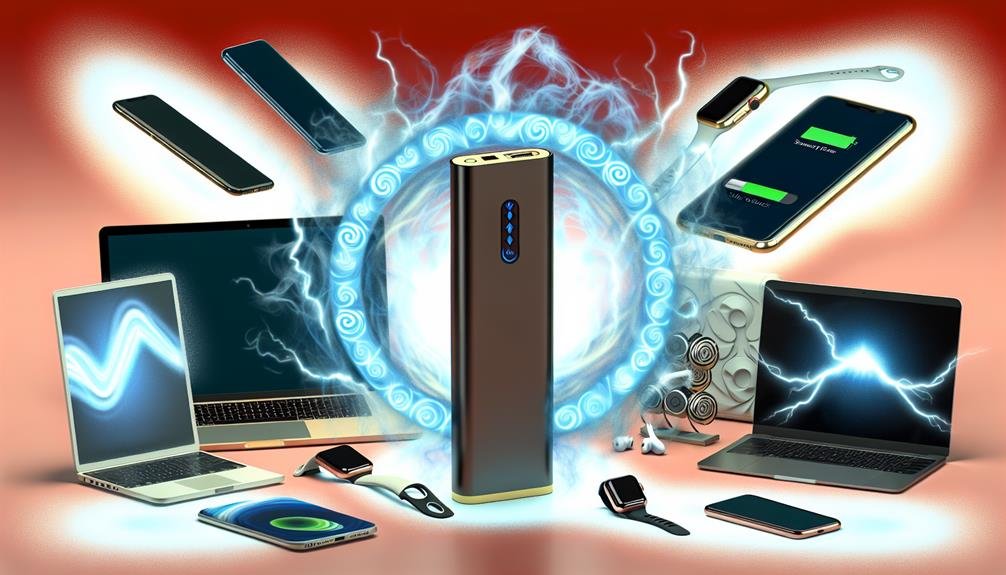
Frequently, misconceptions about mAh ratings can lead to misunderstandings about a power bank's actual performance and capabilities. One common myth is that a higher mAh rating always means better charging efficiency. In reality, mAh only indicates the battery capacity, not how effectively the power is transferred to your device.
Another prevalent mah misconception is believing that the mAh rating on the power bank translates directly to the amount of charge your device will receive. This overlooks the fact that energy loss occurs during the charging process due to factors like voltage conversion and heat dissipation. Typically, a power bank's real-world efficiency ranges between 85-90%, meaning a 10,000 mAh power bank might only deliver around 8,500 to 9,000 mAh to your device.
Lastly, some think that mAh ratings alone determine the safety and reliability of a power bank. While capacity is important, you should also consider the device's build quality, protective features like overcharge and short-circuit protection, and the quality of internal components. Securing these factors enhances charging efficiency and overall safety, mitigating risks associated with substandard power banks. Always verify these specifications to confirm you're making a safe, informed choice.
Frequently Asked Questions
Can Mah Ratings Affect the Weight of a Power Bank?
When it comes to weight impact, higher mAh ratings can make a power bank heavier. In a size comparison, larger batteries generally weigh more. So, keep an eye on those specs to guarantee safety and portability.
How Does Temperature Impact a Power Bank's Mah Efficiency?
Temperature impact can greatly affect a power bank's mAh efficiency. High temperatures may decrease charging speed and overall efficiency, while low temperatures could impair battery performance, reducing its effective capacity and potentially causing safety risks.
What Are the Best Practices for Storing a Power Bank?
Storing a power bank is like preserving fine wine; proper maintenance guarantees longevity. Keep it in cool, dry storage conditions to prevent damage. Charge it to around 50% before storing to maintain battery health and safety.
Are There Any Safety Concerns With High Mah Power Banks?
Yes, high mAh power banks can pose safety concerns. Overcharging risks may lead to overheating or even fires, and excessive use can shorten battery life. Always follow manufacturer guidelines and use quality chargers to mitigate these issues.
Do Power Banks With Higher Mah Charge Devices Faster?
It's a coincidence you'd ask about charging speed. Higher mAh doesn't directly impact charging speed or efficiency. Instead, it affects capacity. Charging speed depends on the power bank's output and your device's compatibility, ensuring safe and efficient use.

